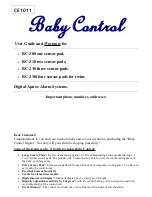
2. Put the cuff on the left upper arm with the
tube pointing toward the palm. If
measurement on your left arm is difficult,
you may use the right arm for
measurement. In this case, be aware that
the readings may differ about 5-10 mmHg
between left arm and right arm.
3. Wrap cuff around your upper arm with the
lower edge of the cuff approximately
.8 - 1.2 in. / 2-3 cm above the elbow. The
mark <
ARTERY
> must be over the artery of
the upper arm.
4. Press the cuff to ensure it is attached
securely. The cuff should not be too tight or
loose. Two fingers should easily fit between
cuff and upper arm.
5. The mark <
INDEX
> on the cuff must point
to area <
NORMAL
> or <
LARGE CUFF
>.
This means the cuff size is correct. If mark
<
INDEX
> points to the area beyond area
<
NORMAL
> or <
LARGE CUFF
>, consult
your distributor to see whether you need
another size cuff.
6. Sometimes it is difficult to make the cuff fit
well, depending on the shape of the user’s
upper arm; the cone-shape assembly of
cuff is also acceptable.
7. If your clothes restrict the blood circulation
of your upper arm, or you roll your sleeve
up so as to result in such restriction, take
off your shirt to get an accurate
measurement if necessary.
9
Содержание LUMISCOPE 1133
Страница 19: ...DATE SYSTOLIC mmHg DIASTOLIC mmHg PULSE beats minute BLOOD PRESSURE RECORD 19...
Страница 25: ...MONITOR DE PRESI N ARTERIAL DIGITAL AUTOM TICA Modelo 1133 Manual de instrucciones 1133 INS LAB RevD20...
Страница 43: ...FECHA SIST LICA mmHg DIAST LICA mmHg PULSO latidos minuto DIARIO DE PRESI N ARTERIAL 43...










































